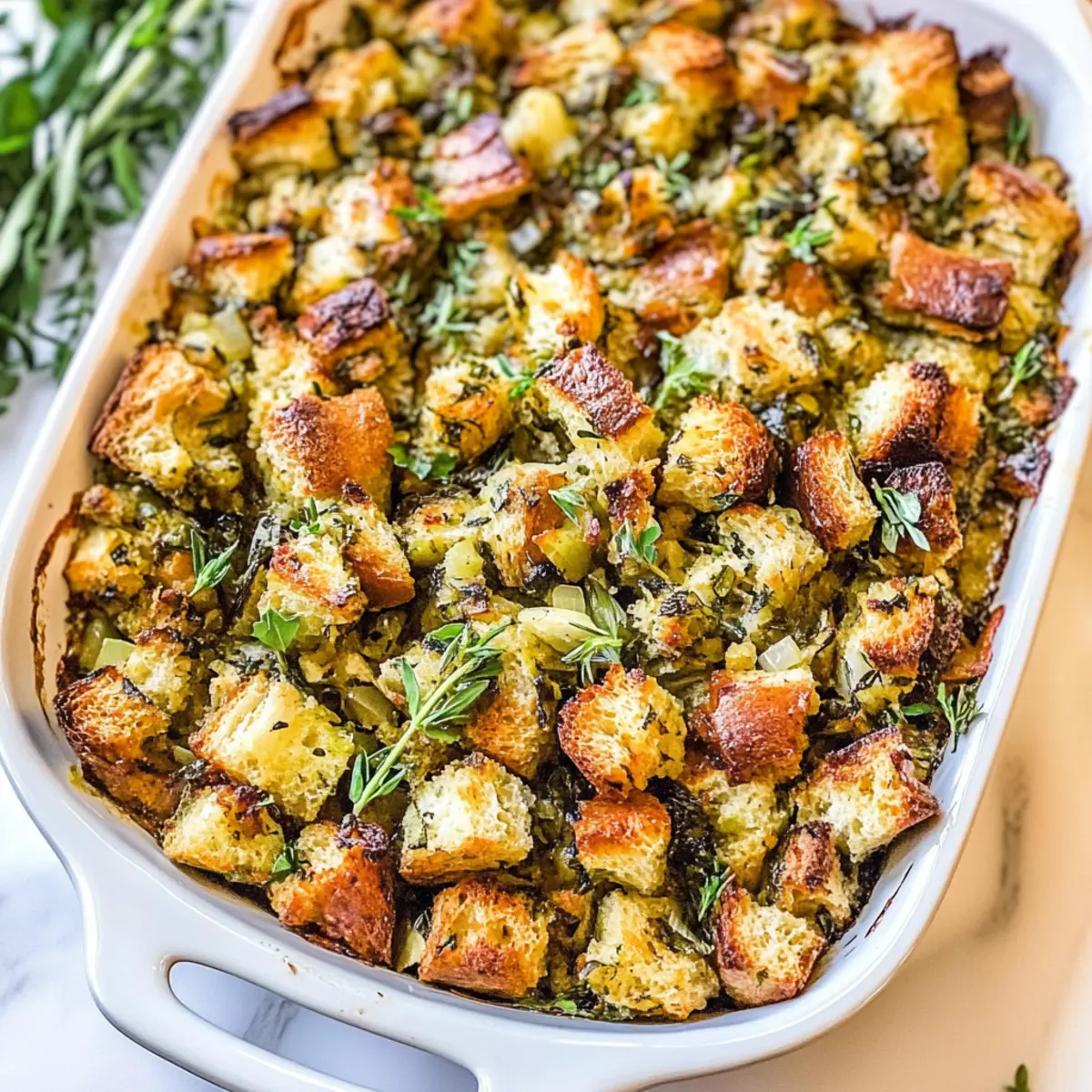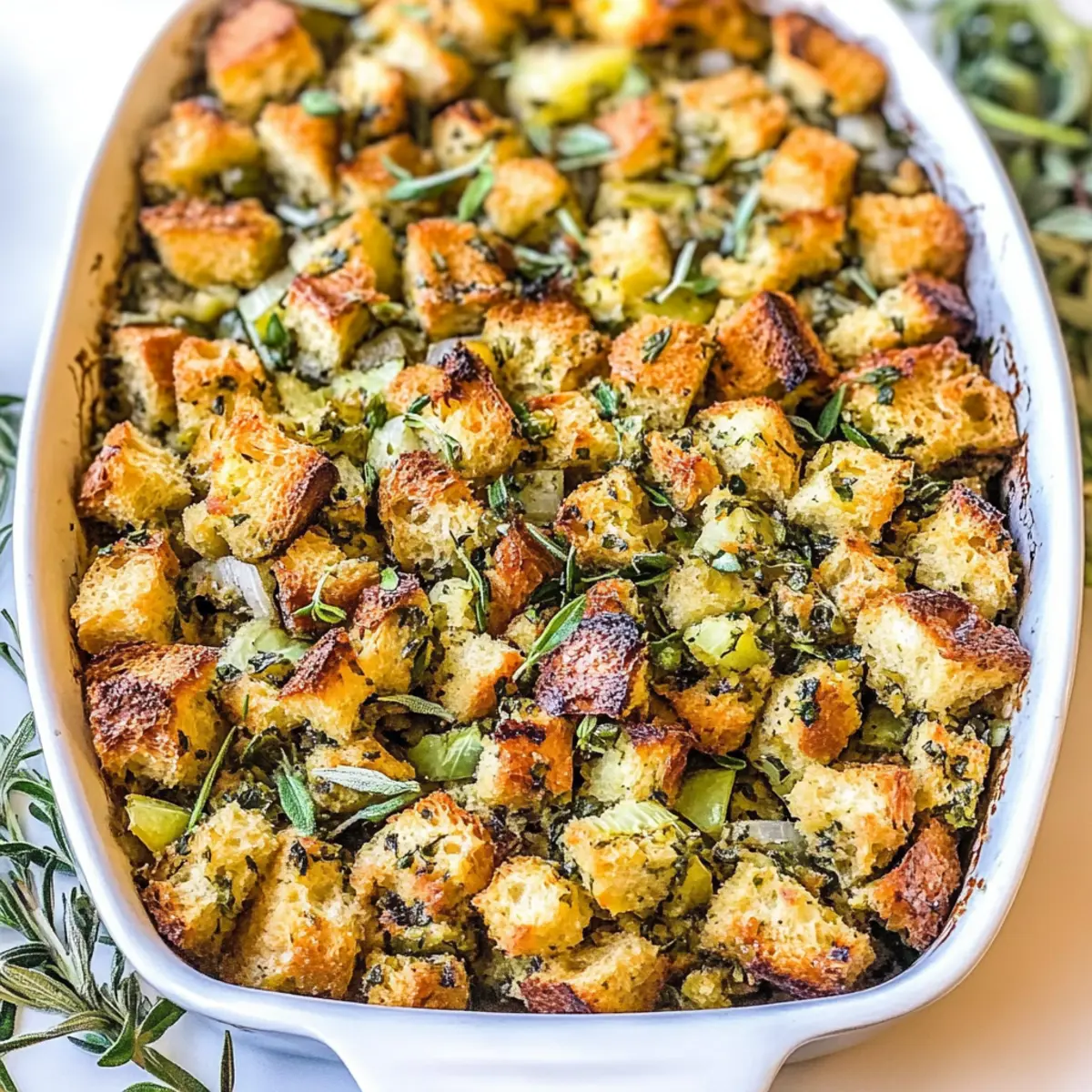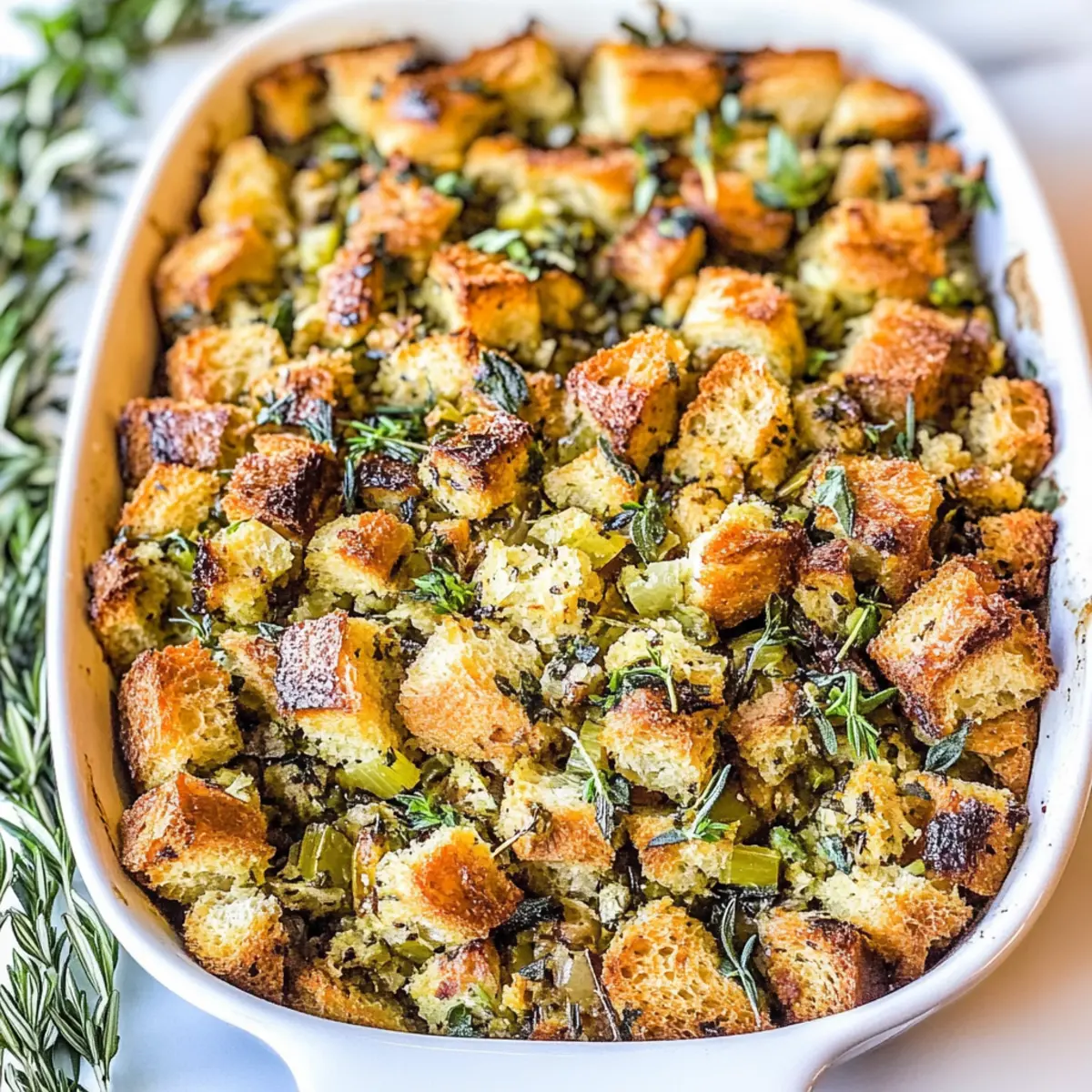As the scent of freshly baked bread wafts through my kitchen, I find myself transported back to the unforgettable Thanksgivings of my childhood. This Traditional Homemade Thanksgiving Stuffing is more than just a side dish; it’s a comforting reminder of family traditions and joyful gatherings. Packed with rich buttery flavors and fragrant herbs, this recipe is set to become a standout on your holiday table. Plus, it’s a breeze to make, allowing both new cooks and seasoned chefs to shine. Not to mention, it’s freezer-friendly, making it a practical choice as you prep for the feast. Are you ready to create a stuffing that will leave everyone asking for seconds?

Why is this the Best Stuffing Recipe?
Comforting Tradition: This Classic Homemade Stuffing captures the essence of Thanksgiving with every bite. Buttery richness and aromatic herbs meld together, creating a beautiful dish that tantalizes your taste buds. Easy Preparation: Designed for all skill levels, this recipe offers a straightforward process, letting you enjoy family moments without stress. Versatile Flavors: Feel free to add your twist! From savory sausage to sweet apples, this stuffing accommodates all preferences. And best of all, it’s freezer-friendly, making it a time-saving choice for your holiday! You’re bound to relish the nostalgic flavors that make this stuffing the star of your Thanksgiving table.
Best Stuffing Ingredients
• Here’s everything you need to make the best stuffing for your cozy Thanksgiving feast!
For the Base
- Unsalted Butter – Helps create a rich, moist stuffing; use salted if needed, but adjust added salt.
- Day-Old White French Bread – Provides a sturdy base; allow it to dry out to prevent mushiness when adding broth.
For the Aromatics
- Sweet Vidalia or Yellow Onion – Adds a delightful sweetness; shallots can be a milder swap.
- Celery – Essential for that crunchy texture and aromatic flavor; leeks can be a good alternative.
For the Herbs
- Italian Flat-Leaf Parsley – Brightens the stuffing with fresh flavor; curly parsley can be substituted with textural changes.
- Fresh Sage, Rosemary, and Thyme – Vital for traditional taste; use dried herbs in smaller quantities if fresh varieties aren’t available.
Seasoning & Moisture
- Salt & Pepper – Elevate the overall flavor; adjust according to your taste preferences.
- Low-Sodium Chicken Broth – Infuses moisture and flavor; switch to vegetable broth for a vegetarian version.
For Binding
- Large Eggs – Essential for binding the stuffing together; flax eggs can be used as a vegan alternative.
Each of these ingredients brings something special to the table, crafting a stuffing that not only embodies tradition but also invites you to make it your own!
Step‑by‑Step Instructions for Best Stuffing
Step 1: Prepare the Bread
Preheat your oven to 250°F (120°C). Spread the cubed day-old white French bread evenly on a baking sheet. Bake for approximately 45 minutes, tossing halfway through, until the bread is thoroughly dried but not browned, achieving a perfect base for your Best Stuffing.
Step 2: Cook Vegetables
In a large skillet, melt ¾ cup of unsalted butter over medium-high heat. Once the butter is bubbling, add 1 cup of diced sweet Vidalia or yellow onion and 1 cup of diced celery. Cook for about 10 minutes until the vegetables are soft and slightly golden, releasing enticing aromas that signal they’re ready to blend into your stuffing.
Step 3: Combine Ingredients
In a large mixing bowl, combine the dried bread cubes from the oven with the cooked onion and celery mixture. Add 1 cup of chopped Italian flat-leaf parsley, 1 tablespoon each of fresh sage, rosemary, and thyme, along with salt and pepper to taste. Drizzle in 1¼ cups of low-sodium chicken broth and gently toss everything together, ensuring each piece of bread is nicely coated.
Step 4: Mix Eggs and Broth
In a small bowl, whisk together the remaining ½ cup of chicken broth with 2 large eggs until well combined. Pour this mixture over the stuffing blend, being careful to combine without breaking apart the bread too much. This binding step is essential for creating that delightful texture in your Best Stuffing.
Step 5: Transfer to Baking Dish
Grease a 9×13-inch baking dish with butter to prevent sticking. Carefully transfer the stuffing mixture into the dish, spreading it out evenly. Dot the top with the remaining butter for added flavor, then cover the dish tightly with aluminum foil, which helps retain moisture while baking.
Step 6: Bake
Place the covered baking dish in your preheated oven and bake for 40 minutes. Then, remove the foil and continue baking for an additional 40 to 45 minutes. The stuffing should emerge with a beautiful golden-brown crust on top, ready to offer its comforting aroma that fills your kitchen.
Step 7: Serve
Remove the Best Stuffing from the oven and allow it to cool slightly before serving. Enjoy it warm alongside your favorite Thanksgiving dishes, knowing this classic side will surely bring smiles to your family’s faces. Store any leftovers in the refrigerator for up to five days, reheating gently to maintain its irresistible flavors.

Make Ahead Options
Preparing this Traditional Homemade Thanksgiving Stuffing ahead of time is a game-changer for those busy holiday weeks! You can cube and dry your bread up to 24 hours in advance, ensuring it’s perfectly stale for the best texture. Additionally, the aromatic vegetable mixture can be sautéed and stored in the refrigerator for up to 3 days. When you’re ready to assemble your stuffing, simply combine the prepared components in a baking dish, add the broth and eggs, and bake as directed. For optimal freshness, cover tightly and refrigerate the unbaked stuffing overnight, then add a splash of broth before putting it in the oven to ensure it remains moist. With these make-ahead options, you’ll save precious time on the big day while serving up a stuffing that is just as delicious!
Expert Tips for the Best Stuffing
-
Use Day-Old Bread: Ensure your bread is stale; this absorbs the broth better and prevents soggy stuffing. Leaving it out overnight or baking it first works wonders!
-
Customize Herbs: While this recipe uses fresh sage, rosemary, and thyme, feel free to experiment with your favorite herbs for the best stuffing that suits your taste.
-
Broth Adjustments: If using regular chicken broth, taste for salt before seasoning the stuffing. Low-sodium versions help control the saltiness better.
-
Add Sweetness: Consider mixing in diced apples or dried cranberries for a sweet twist. Their flavor pairs beautifully with the savory elements of this traditional stuffing.
-
Pre-Assembly Tip: If making ahead, add a little extra broth before baking. This keeps the stuffing moist and flavorful, ensuring it’s perfect when it’s time for your feast.
-
Golden Brown Top: Baking uncovered for the last 40-45 minutes gives the stuffing a beautifully crusted top while keeping the inside soft and moist.
What to Serve with Traditional Homemade Thanksgiving Stuffing
Savoring this stuffing sets the stage for a memorable Thanksgiving feast, creating a delightful harmony of flavors across your table.
-
Roast Turkey: A classic pairing that blends perfectly with the stuffing’s savory herbs and buttery texture. The juicy turkey provides a wonderful contrast.
-
Cranberry Sauce: The tartness of cranberry sauce complements the rich flavors of the stuffing, offering a refreshing balance that brightens every bite.
-
Green Bean Casserole: This dish adds a creamy texture and earthy flavors, contrasting beautifully with the stuffing’s softness and helping to create a comforting side spread.
-
Mashed Potatoes: Creamy mashed potatoes nestled next to your stuffing create a dreamy duo, especially when smothered in rich gravy, making every mouthful a comforting delight.
-
Sweet Potatoes: Whether candied or roasted, their natural sweetness pairs wonderfully with the savory stuffing, creating enticing flavor layers that excite the palate.
-
Duck or Goose: For a festive twist, serving this stuffing alongside roasted duck or goose offers a luxurious experience, enhancing the celebration with rich, aromatic flavors.
-
Apple Pie: A timeless dessert that rounds off your meal. The warm, sweet goodness of apple pie creates a nostalgic finale for the perfect Thanksgiving feast.
Consider these comforting options to elevate your Thanksgiving and watch as they transform your meal into a heartwarming celebration of flavor!
Best Stuffing Variations & Substitutions
Feel free to get creative and customize your stuffing for an even more delightful experience!
-
Sausage-Infused: Brown some Italian sausage before adding it to the mix for a hearty, flavorful touch. The savory notes of the sausage will beautifully complement the richness of the stuffing.
-
Fruit Sweetness: Toss in diced apples or dried cranberries for a sweet contrast that adds delightful bursts of flavor in each bite. These additions will bring a lovely balance to the spices and herbs.
-
Cornbread Shift: Use crumbled cornbread instead of white French bread for a Southern twist. This changes the stuffing’s texture and flavor profile while keeping it deliciously comforting.
-
Veggie-Loaded: Add sautéed mushrooms or spinach for an earthy and nutritious boost. A handful of freshly chopped spinach mixed in before baking can elevate the healthy aspect of your dish.
-
Nutty Crunch: Stir in some toasted pecans or walnuts for a delightful crunch. This unexpected twist not only adds texture but also a nutty richness to your stuffing.
-
Herb Alternatives: Swap out traditional herbs for your favorites such as basil or cilantro. This allows for a fresh take while giving you the chance to personalize your stuffing experience.
-
Spicy Kick: If you love heat, add a pinch of crushed red pepper flakes or some chopped jalapeños. Their warmth will add an exciting twist that takes this classic dish to another level.
-
Gluten-Free: Use gluten-free bread or cornbread as a substitute for the white French bread. It’s an excellent option that ensures everyone at the table can enjoy this beloved Thanksgiving side.
Don’t forget, variations can be a great way to use up leftovers—think of those delicious roasted vegetables you want to incorporate! Whatever twist you choose, you’re destined to create a stuffing that will become a family favorite.
How to Store and Freeze Best Stuffing
Fridge: Store leftover best stuffing in an airtight container in the refrigerator for up to 5 days. Reheat gently in the oven to maintain its moist texture.
Freezer: For longer storage, wrap cooled stuffing tightly in plastic wrap and then in aluminum foil. It can be frozen for up to 2 months. Thaw in the fridge overnight before reheating.
Reheating: To reheat, place stuffing in a baking dish, cover with foil, and bake at 350°F (175°C) for 20-30 minutes, or until heated through. Optional: uncover for the last few minutes for a crispy top!

Best Stuffing Recipe FAQs
How do I select the right type of bread?
Absolutely! For the best stuffing, day-old white French bread is ideal because it dries nicely without turning too hard. Look for bread that has a firm crust and a soft interior. If you can, avoid bread with added ingredients like seeds or grains, as they can alter the texture. You can also use sourdough or Italian bread, but ensure it’s dried out properly first.
How should I store leftover stuffing?
Very! Store your leftover best stuffing in an airtight container in the refrigerator for up to 5 days. Be sure to let it cool completely before sealing it up to prevent condensation, which can make it soggy. When you’re ready to enjoy it again, reheating gently in the oven will help maintain its wonderful texture.
Can I freeze the stuffing?
The more the merrier! To freeze, wrap the cooled stuffing tightly in plastic wrap and then in aluminum foil to protect it from freezer burn. When properly sealed, your best stuffing can last for up to 2 months. When you’re ready to use it, thaw it in the refrigerator overnight, then reheat as mentioned for that fresh-baked taste.
What should I do if my stuffing is too dry?
No worries, this happens! If you find your stuffing is on the dry side after baking, try adding a bit more broth while reheating to revive it. Simply pour in small amounts, toss gently to mix, and cover with foil as you warm it in the oven to keep the moisture locked in.
Is this stuffing recipe suitable for my vegetarian friends?
Certainly! To make your best stuffing vegetarian-friendly, simply swap the low-sodium chicken broth for vegetable broth, and you’re good to go! This keeps all those comforting flavors intact while making it inclusive for everyone at the table.
Can I make stuffing in advance?
Absolutely! You can assemble the stuffing a day ahead. Just prepare it until the baking step, then cover tightly and refrigerate. When you’re ready to bake, pour in a little extra broth to keep it moist and follow the baking instructions. Your eyes will light up when you see how simple it is to pull off a perfect Thanksgiving side dish!

Best Stuffing Recipe for a Cozy Thanksgiving Feast
Ingredients
Equipment
Method
- Preheat your oven to 250°F (120°C). Spread the cubed day-old white French bread evenly on a baking sheet. Bake for approximately 45 minutes, tossing halfway through.
- In a large skillet, melt ¾ cup of unsalted butter over medium-high heat. Once the butter is bubbling, add 1 cup of diced sweet Vidalia or yellow onion and 1 cup of diced celery. Cook for about 10 minutes until soft and slightly golden.
- Combine the dried bread cubes with the cooked onion and celery mixture. Add 1 cup of chopped parsley, 1 tablespoon each of fresh herbs, along with salt and pepper. Drizzle in 1¼ cups of chicken broth and toss together.
- Whisk together the remaining ½ cup of chicken broth with 2 eggs. Pour this over the stuffing blend, combining gently without breaking apart the bread too much.
- Grease a 9x13-inch baking dish with butter. Transfer the stuffing mixture into the dish, spreading it evenly. Dot the top with the remaining butter, then cover with aluminum foil.
- Bake covered for 40 minutes. Remove the foil and bake for an additional 40 to 45 minutes until golden-brown.
- Cool slightly before serving. Store leftovers in the refrigerator for up to five days.

Leave a Reply